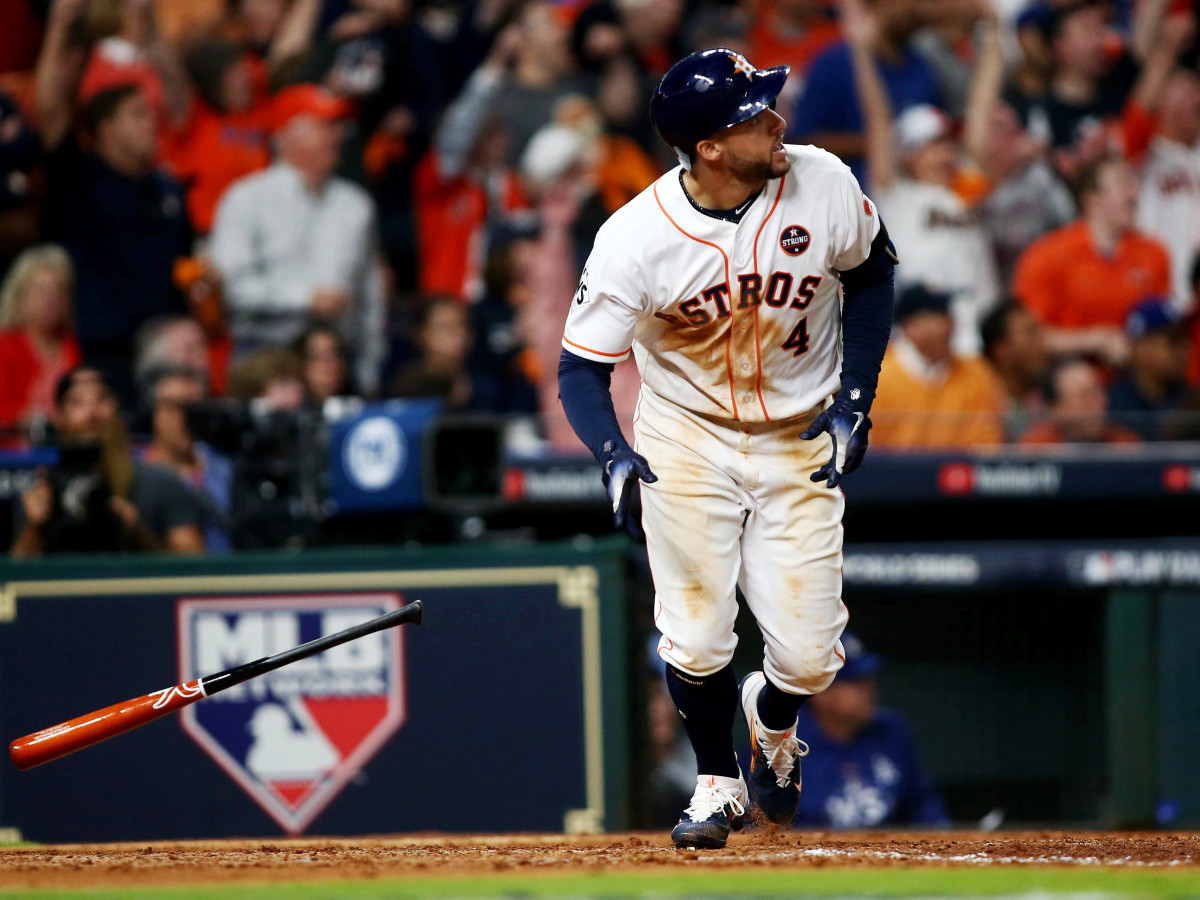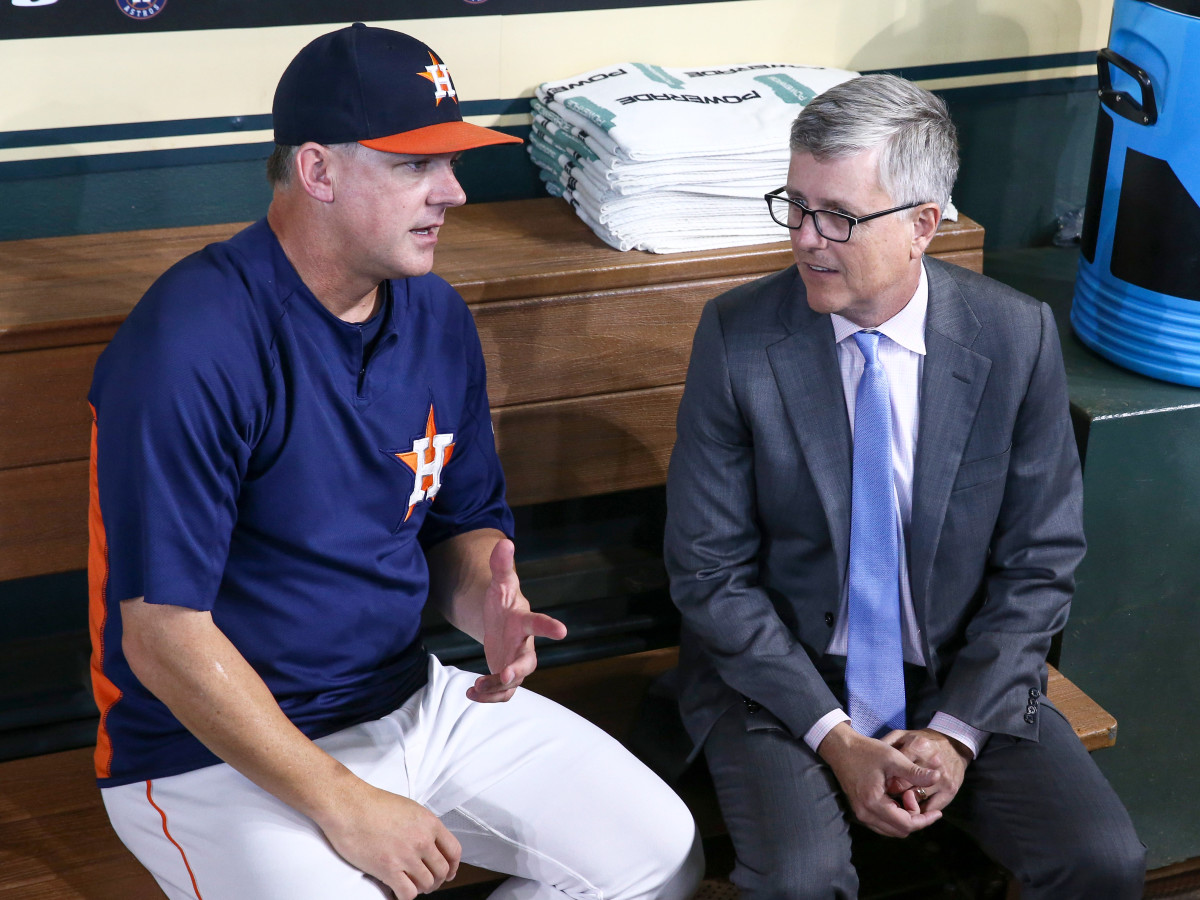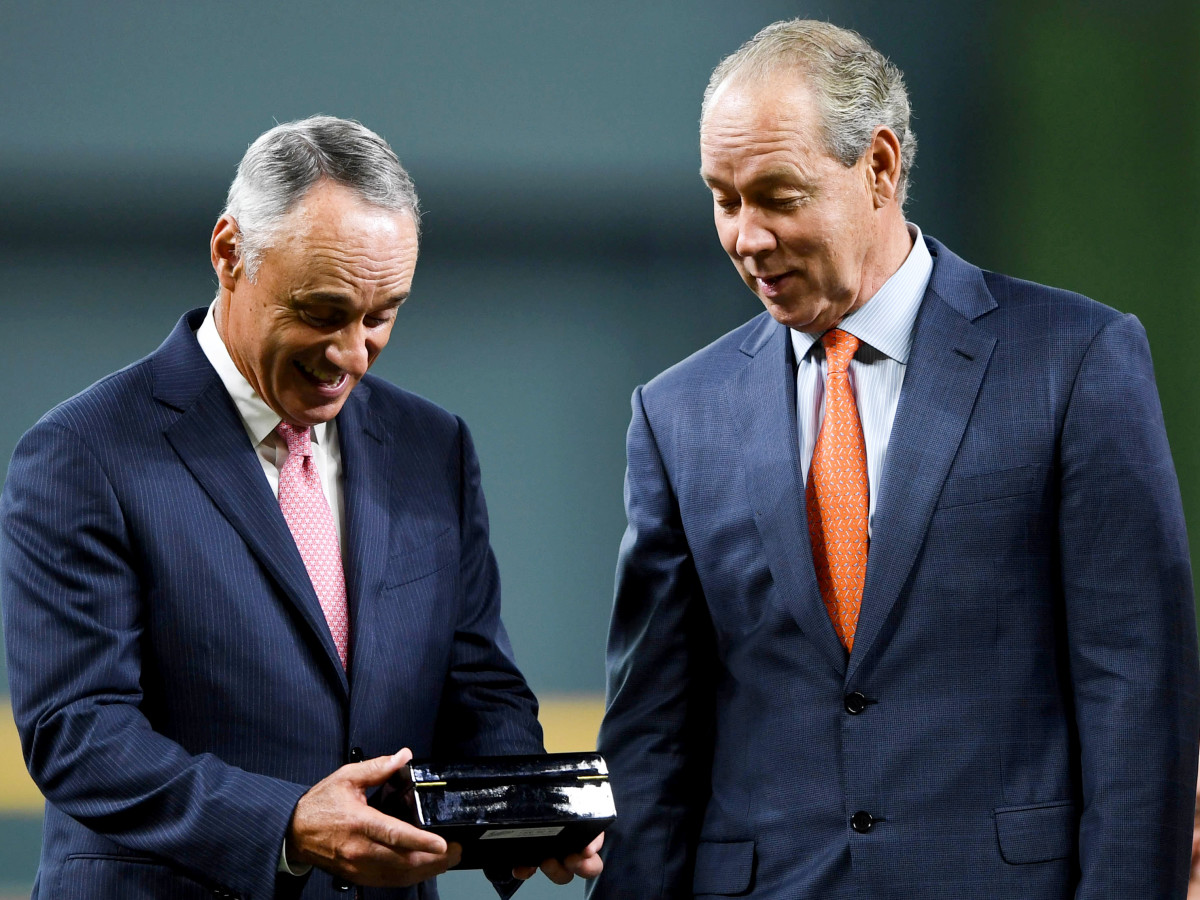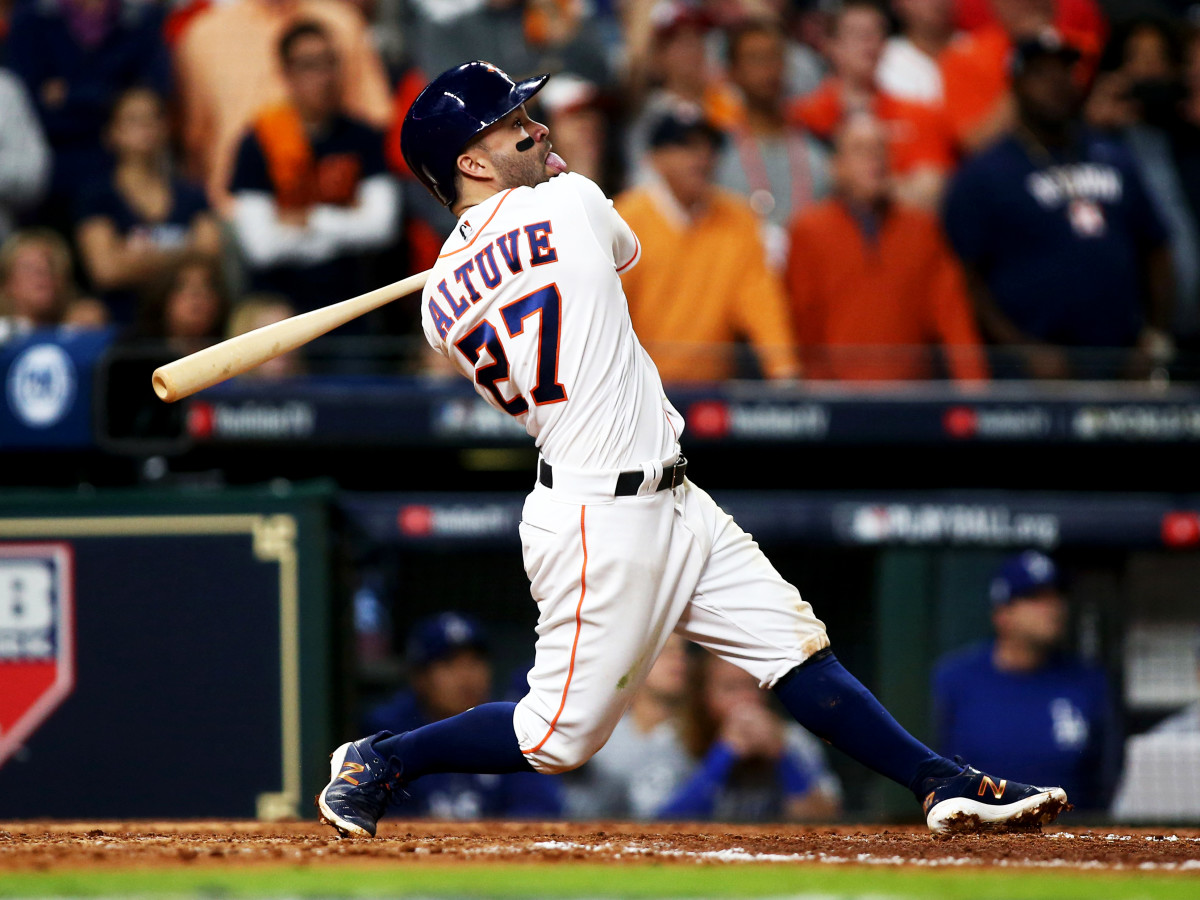Baseball's Fight to Reclaim Its Soul

The enormous fallout from the Houston Astros’ sign-stealing scandal has pushed baseball into a moment of crisis. The root cause of the scandal is embedded in the nine-page report by commissioner Rob Manfred: technocrats gaining power in how the game is played.
Amid all the outrage and the reviews of press conferences and interviews as if they were performance art, union chief Tony Clark issued the most important words in a statement last week that should have received more attention:
“How the parties handle the next several weeks will significantly affect what our game looks like for the next several decades. The opportunity is now to forge a new path forward.”
Manfred has vowed to reduce the live video available in and around clubhouses. It’s a start toward winning back trust. “That’s a joint obligation,” Manfred said. “It’s something we have to do and something the players have to us help us do.”
Discussions with the union have included an all-out blackout: video rooms closed, clubhouse televisions off, no more running inside to look at video during a game. Managers overwhelmingly favor the blackout. Several of them briefed by Manfred last week expect it to happen. It is the first step toward re-balancing baseball to be more of a player-driven game than a front office-driven one.

“Get rid of it,” said Arizona catcher Stephen Vogt. “Get rid of the in-game video. It’s hard because sometimes you want to study your swing and go back and look at a pitch and see what it’s doing.
“But I’m all for removing all in-game technology. Let’s go back to six, seven years ago when we just didn’t have this instant feedback from all these cameras. Technology has really enhanced our game in a lot of ways, but it’s also created opportunities for people to take advantage of it, to take it further than it should have. If you want to work on that in between games, yes. It’s called preparation.”
Baseball is in a fight to reclaim its soul. That soul of the game must be found in its aspirational value: players of all sizes playing a simple kids’ game. The conceit we like to keep is that this is our game writ slightly bigger.
Baseball lost its soul under a growing technocracy. Brutish efficiency and cold, inarguable algorithms guide searches for the smallest of advantages. To be abundantly clear, the Astros are not evidence that this embrace of information and technology is wrong. It’s provided much good for the game, especially as a training tool. The Astros are the warning shot of what happens when it goes too far.
Games are being decided in real time, not just on the field but also in front of computers, often in clubhouses. Analysts overlay in-game video of the opposing pitcher to see if he is tipping his pitches, replacing human craft. Others monitor thousands of real-time data points to watch if their pitcher is dropping his elbow by an inch or two. Why do clubhouses look like start-up labs during games? Why is the replay monitor even in the clubhouse and not in a press box booth or TV trailer?
“The Houston Astros are a product of their environment,” said agent Scott Boras. “When fans go to games, they don’t want to know that the manager is not the one making the moves. You’ve got to create theatre, drama. I don’t care about efficiency. I care about the audience to help our game grow.
“My biggest problem with this thing is it came from the front office. Jeff Luhnow buried the memo from Rob.”
Baseball is borrowing ethos from Wall Street. Banking and stock trading are not spectator sports. Brewers manager Craig Counsell said the biggest change over his five years managing is the population of the room in staff meetings to plan spring training: it swelled from about 10 people to 45. The Dodgers last week introduced their R&D staff to their players: 12 of them, or about one analyst for every two players on the 25-man roster.
The Astros’ scandal was not wholly “player-driven” any more than is the game itself. We have a game so driven by metrics that players choose not to run from first base on a full count and less than two outs because they know a caught stealing hurts their Wins Above Replacement. (Yes, it happens.) We have a game in which 35% of all plate appearances end in a strikeout, walk or home run, when athleticism is moot. We have a game that saw a decline in attendance even with a spike in offense—the first time in 50 years that tried-and-true correlation didn’t work in tandem. We have a game that takes longer than ever: three hours, 10 minutes on average.
This is the game we get when knowledge is valued over wisdom.
What the Astros did, layered over what the Padres did (fuzzy medical records), what the Cardinals did (hacking) and what the Braves did (cheating on international signings), demands a deep examination of how the game is played and where it is going.

“A lot of front offices are going away from hiring former baseball players,” Dodgers ace Clayton Kershaw said. “I’m not saying it’s right or wrong. A lot of teams almost alienate the former player, saying they don’t want that in their front office. They don’t want that in their clubhouse. They don’t want that influence of old school baseball.
“They want a lot of guys with Ivy League degrees crunching algorithms and figuring out if you spin your fastball up in the zone two percent more you’re going to have this effect more. Great. I understand it. I’m not naive to that. [But] there’s a place in the game for guys who really know baseball.
“I think the Dodgers do a good job of that. As many guys as we have that are from Harvard or Yale or whatever, Ivy League guys, we also have Raúl Ibañez around. We have Chase Utley. We have Jamey Wright. We have a lot of guys around who played in the big leagues 15-plus years and that’s invaluable.
“You have to have that around, almost to balance everybody out. Because a lot of guys up there—now some of them do it well—but a lot of them who didn’t play don’t really understand how hard the game is. They show you what to do and then they’re like, ‘Why is he not doing this? Why can’t he do this?’ They just kind of take the human element out, too. You need both. There’s no doubt in my mind you need both.”
Manfred thought he created closure to the Houston scandal by suspending for a season manager A.J. Hinch, general manager Jeff Luhnow and assistant GM Brandon Taubman (who was bounced for an ugly rant directed at female reporters). The penalties were harsher than any ever associated with stealing signs.
But Manfred acted only against Hinch and Luhnow for a failure to act. He did nothing about the actual actors in the schemes. Luhnow’s hand-picked lieutenants—the technocrats—provided the runway to the trash-can banging scheme. They operated in-game schemes themselves under Codebreaker, the name they gave to their nefarious sign stealing first reported by the Wall Street Journal.
Opposing players could not reconcile the report with the subsequent disclosure of Codebreaker. To that complaint Manfred responded, “I think in their concerns about a lack of transparency is they don’t quite understand how those two systems work together, which I think the report made clear. The Codebreaker system in and of itself could have been perfectly legal. It started as a non-in-game effort to decode signs. Lots and lots of teams do that. It doesn’t violate our rules.
“What the report made absolutely clear was that at the same time they were developing Codebreaker the video monitor/trash can system emerged. They got a little nervous about that. Then they started using Codebreaker in an inappropriate way.”
What the Astros did with technology should scare Manfred about where the game is headed.
“Stem cell management, cleats that allow you to jump five feet, and what else?” Boras said. “We need to have an independent medical board to be ready.”
***

Luhnow, the man running the Astros baseball operations, did not love baseball enough to make it his life’s work. “At no point was I planning to go into sports or baseball,” Luhnow (Penn ’89) once told The Daily Pennsylvanian. For 14 years he worked as an engineer, a McKinsey consultant and a tech entrepreneur. His only connection to baseball was taking part in a fantasy league.
Then in 2003 a former McKinsey colleague helped him land a job with the Cardinals. The Astros hired him in December 2011.
In June of 2013 Luhnow posted an opening in his baseball operations department. He didn’t want an actual baseball person. He wanted someone from banking. Taubman (Cornell ’07) answered. Taubman was a Wall Street derivative valuations expert who last played baseball on the junior varsity team at Syosset High School on Long Island, N.Y. He was making side money beating people at online fantasy baseball with a statistical model he once described as a "hacked-together, Excel-spreadsheet, SQL-server-sourced" optimizer.
It wasn’t too big a leap to treat major league players as derivatives or fantasy picks. He took a pay cut to work for Luhnow as “economist, baseball operations.” Luhnow promoted Taubman four times in the next five years, all the way to his right-hand man as assistant GM.
Three months after hiring Taubman, Luhnow hired Tom Koch-Weser (Illinois ’04), who had been manager of advance information for the Seattle Mariners from 2009-13. Shortly after his hiring, Koch-Weser pulled aside Dave Trembley, a baseball lifer who was Houston’s bench coach after serving the previous season as third-base coach.
Trembley, 68, told the Post and Courier of Charleston, S.C., that Koch-Weser told him, “Be careful giving signs from the bench. Last year in Seattle we played you guys 18 times and we had a camera on your bench coach and third-base coach and we had all your signs.”
Such use of technology to steal signs was illegal in baseball since 2000 under protocols established under MLB executive Sandy Alderson.
Said Trembley, “A red light went on for me. It was like, ‘Why is this guy here?’ In my wildest dreams I could never have imagined that this is where it would end up. But the culture there was just different.”
That same year, in February of 2014, Luhnow hired Matt Hogan (Wisconsin ’09) from Stats LLC as an apprentice in advance information. Hogan rose quickly. In 2017 he was the coordinator of Major League Advance Information when, as he told investigators, Luhnow saw him and other personnel Codebreaking in the video room. Luhnow denied seeing such work.
In spring training 2016 Luhnow hired a fellow Penn graduate as a Spanish translator. Derek Vigoa (Penn ’12) had worked four years in sponsorship and consulting businesses.
Six months later, Vigoa was in the clubhouse when Astros rookie third baseman Alex Bregman mentioned that other teams were better than Houston at picking up signs from second base, an accepted practice in baseball. Vigoa offered help. He created an Excel-based application in which an Astros employee would input the catcher’s signs and the outcome of the pitch. An algorithm in the app decoded the signs.
On Sept. 22, 2016, Vigoa showed his work to Luhnow in a PowerPoint presentation. The name of the app was Codebreaker. Luhnow told investigators he considered it legal advance scouting. Two months later, Luhnow promoted Vigoa to manager, team operations.
Early the next season, 2017, Koch-Weser sent two e-mails to Luhnow regarding “our dark arts.” In the first one, on May 24, Koch-Weser seemed to acknowledge the ethical line they were crossing when he wrote, “I don’t want to electronically correspond too much about ‘the system’ but Cora/Cintrón/Beltrán have been driving a culture initiated by Bregman/Vigoa last year and I think it’s working …”
Luhnow wrote back, “How much of this stuff do you think [Hinch] is aware of?”
Taubman proudly referred to the codebreakers, analysts and quants as “The Nerd Cave.” When the 2017 season began, they were hard at work decoding signs from the video replay room behind the dugout using a live feed. Two months into the season, DH Carlos Beltrán wanted an even better system. The trash can scheme was born. It did not emerge out of nowhere. It emerged from the behavior and culture of the front office.
In August, with the trash can system in full force, according to reports, director of pro scouting Kevin Goldstein sent an e-mail to his scouts asking them to spy on potential postseason opponents with electronics. That same month the Astros laid off eight scouts as they transitioned to a team that relied more on data and video for information than human observation.

Two months later, the Astros trailed Boston, 3-2, in the top of the eighth inning of ALDS Game 4 when Bregman pulled a 2-1 slider from ace Chris Sale for a home run. Vigoa was in the clubhouse with players at the time watching on various screens. “As soon as he hit it, we all erupted,” Vigoa told The Pennsylvania Gazette. Houston would go on to win, 5-4, to clinch the series.
The Astros won the World Series. Vigoa and Hogan received promotions. Vigoa was promoted again last November to director of team operations, just as the scandal was about to break. Koch-Weser, Goldstein, Vigoa and Hogan all remain with the club.
The next year, 2018, the Astros stationed someone named Kyle McLaughlin in camera wells near the dugouts of the Indians (their ALDS opponent) and Red Sox (their ALCS opponent) to surveille those teams with a cellphone camera. The Astros claimed to have done so as a means of “playing defense” against sign stealing. McLaughlin was not listed as an Astros employee, but did have connections to Crane.
McLaughlin (University of Florida Online, ’19) is from Palm City, Fla., where he was recruited to pitch for Farleigh Dickinson. After suffering a shoulder injury, he transferred to Central Florida. According to UF Online, McLaughlin then enrolled in online classes at Florida, which allowed him to work “in operations in Palm City and Texas.” Palm City is home to The Floridian, an exclusive golf club owned by Crane. McLaughlin has been photographed with Crane and in front of an airplane bearing the logos of Crane’s businesses.
The money quote from Manfred’s report, which got lost in the noise over the low-tech absurdity of the trash can and the suspensions of Hinch and Luhnow, is this, with emphasis added:
“The baseball operations department’s insular culture – one that valued and rewarded results over other considerations, combined with a staff of individuals who often lacked direction or sufficient oversight, led, at least in part … to an environment that allowed the conduct described in this report to have occurred.”
***

As much as we want baseball to be a refuge, it can be a mirror on society. Jackie Robinson took the field at Ebbets Field five years before the Supreme Court began to hear Brown vs. Board of Education. Cocaine and performance-enhancing drugs took root in clubhouses as they did so outside of them. Now the fight for the game’s soul is not unlike our struggle to grasp how quickly technology is changing society, in which being “liked” by strangers can hold more social value than being liked (without quotes) by known persons.
Ask front office executives about the style of baseball they have wrought and they will talk proudly about its improved “efficiency.” (The stolen base becomes the rotary phone.) But in truthful moments they also admit as an entertainment option the product is awful. It is the dilemma of the age: executives, who have seized power from managers, are motivated by ruthless efficiency but draw no motivation from aesthetics.
“Analytics have come into the game not because it’s a championship-driven dynamic,” Boras said. “It’s a cost-savings dynamic and in my mind is about how we better use the less talented players.”
Baseball set an all-time home run record last year. Runs per game increased by more than three-quarters of a run. It marked the eighth time since 1970 that runs per game jumped by 0.60 or more. But this was the first time that attendance went down with such a sharp increase in offense:
Highest Runs Per Game Increase Since 1970
Year | Runs Per Game Increase | Attendance Per Game Percent Change |
|---|---|---|
1973 | 1.04 | Up 6.8% |
1993 | 0.96 | Up 16.7% |
1977 | 0.96 | Up 12.3% |
2019 | 0.76 | Down 1.6% |
1976 | 0.72 | Up 4.9% |
1994 | 0.64 | Up 0.9% |
1987 | 0.62 | Up 9.4% |
1982 | 0.60 | Up 11.1% |
Here’s what that means: the game needs so much fixing that not even more offense alone can save it. The biggest crisis facing baseball is the slowing of the pace of action—one ball put in play every three minutes, 42 seconds. Players dawdle, but here again the growth of information is at work. Pitchers carry cards in their hat with numbered sign systems to use with the catcher, guarding against the technology-driven espionage in every clubhouse. Teams use multiple signs sometimes even with nobody on base.
“It takes a lot out of you,” Vogt said. “It takes a lot more thinking. It takes the pitcher off his game a little bit and the catcher. You’re thinking about what sign and what system to give them, not just the next pitch. And the pitcher is looking in trying to remember what sign system you’re using in every situation. It definitely takes a lot more mental focus. It definitely changes the mindset and changes the emotion. It changes a lot.”
Manfred has nipped and tucked at the pace problem with insignificant results. Worse, this year he crossed the Rubicon by messing with the strategy of the game. He is tying a manager’s hands with an illogical risk:reward equation: pitchers must face at least three batters, up from one, even though the use of such specialty relievers has declined steadily and the net time saved is about 30 seconds per game.
“These one-offs are not doing anything to the game,” said one executive. “I have told the commissioner’s office I am in favor of any comprehensive proposal that gets the game down to like 2:45. I personally think the time of game thing is real, not just pace or action. Time is a big deal.
“So let’s put a comprehensive plan together in which we can prove within some margin of error how much time we’re taking off the game. It’s going to include some things players aren’t going to like. It’s going to include pitch clocks. It’s going to include batter’s box rules. But you sell it as a way to get to 2:45. Going from 3:05 to 3:02 does nothing.”
Astros players are in for a miserable season. They will expect the blowback to stop, but it will not. The choices made by the players, regardless of the front office culture around them, are so injurious to the integrity of the game that they must wear the questions, scrutiny and ridicule without complaint.
“To me it was unfathomable,” Vogt said. “I couldn’t even wrap my mind around the fact that that actually happened. I couldn’t. It blew my mind. The fact that it was actually happening … it’s just so far from my radar, so far from any thought I’ve had, I literally could not believe it.”
Vogt began to think about a game on April 28, 2017, in Houston, when he was behind the plate as the Astros pounded three Oakland pitchers for nine runs and 14 hits.
“I remember specific pitches where I was like, ‘Man, there’s no way a human being can take that pitch,’” Vogt said. “Stuff like that. It’s not the hitting—well, obviously, it is—but to me it’s the 1-2 slider that gets taken that everybody in baseball swings at. That makes the catcher and the pitcher wonder if something is going on.”
The 2017 Astros led the majors in runs. They hit nine points higher than any other team, including a major league high .294 with runners in scoring position. They hit eight points higher against breaking pitches than any team. They had the lowest swing and miss rate.

“Looking back on it, I feel bad,” said one executive, “because we went through some hitting coaches, like a lot of teams did. We wondered why we weren’t getting results the way Houston did.”
In the coming weeks Manfred and Clark need to sit together at a news conference and give fans confidence this cannot happen again. The first step is confining technology to a tool to prepare for games, not a “dark art” to decide them in real time.
“Turn it off,” Cubs manager David Ross said. “I understand why guys go back there. But I also know it’s a powerful thing to have teammates all out there on the bench cheering you on, knowing that they are more invested in your at-bat in the moment than they are in their own at-bat from the last inning.”
Said Kershaw, “I wish it was that black and white. Me personally, I don’t need it a bit. I know what I’m trying to do and it’s not going to make sense for me to use it there. I just need to go compete. Some guys just love to see their swing and see how they approach the ball, and that helps them in whatever way. I don’t think you should take that away from them.
“That stuff is valuable, so to me it’s not super black and white. What is black and white is no ability to relay signs in real time to the hitter. We do away with that. Whatever it may be—put the TVs on a delay, take away the centerfield Hawkeye camera for that game and let them see it after the game … But once the game starts it’s off. Whatever it is. I don’t know the answer, but to me that’s plenty. I’m great with that and it’ll get back to the way it was.”
Vogt and Kershaw are not talking about getting back to an age of flannel uniforms. It was only 10 years ago that the average nine-inning game took 15 fewer minutes than one from last year. It was only five years ago that Kershaw and catcher A.J. Ellis had the Dodgers’ video room virtually to themselves, pouring over hitters to see who had trouble with a down-and-in slider, for instance. Now the room is filled with non-uniformed wizards scouring data and video for the smallest incremental edge.
As Clark said, the next several decades of baseball are on the line in the next few weeks. Manfred and Clark must decide what kind of game they want. Do they want R&D departments, click-clacking on laptops and dissecting video, to be part of the in-game competition, like bullpens and benches? Do they want championships decided by who can build the next Codebreaker? Do they want players hanging out in video rooms when in the course of looking at their swing they can pick up signs? Do they want a game that continues to lose fans by giving them less action over a longer period of time?
These are complicated times. But baseball’s guiding principle through this crisis must be simple. It should be the most basic demand we have of all sporting competition: that the outcome is decided by the players in the arena, all in full view of us.
